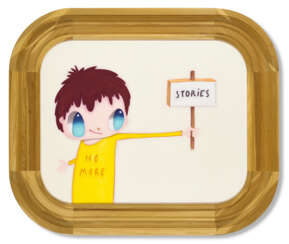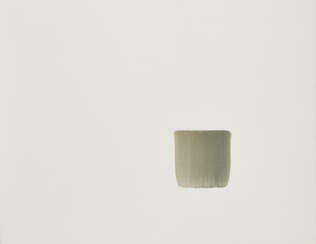
Paintings — 20th/21st Century Day Sale

Takashi Murakami is a Japanese contemporary artist. He works in fine arts media (such as painting and sculpture) as well as commercial (such as fashion, merchandise, and animation) and is known for blurring the line between high and low arts as well as co aesthetic characteristics of the Japanese artistic tradition and the nature of postwar Japanese culture and society, and is also used for Murakami's artistic style and other Japanese artists he has influenced.

Louise Bonnet is a Swiss surrealist painter informed by alternative comix and dark humour. Her grotesque, corporeal figures often dominate the dreamlike settings they exist in, drawing on themes of gender, sexuality, and shame.

Genieve Figgis is an Irish artist who started her artistic career using social media. She is known for her vibrant colors and ghoulish or macabre imagery.
Figgis' style strikes a balance between figuration and abstraction.

Yoshitomo Nara is a Japanese artist. He lives and works in Nasushiobara, Tochigi Prefecture, though his artwork has been exhibited worldwide. Nara has had nearly 40 solo exhibitions since 1984. His art work has been housed at the MoMA and the Los Angeles County Museum of Art (LACMA).

Chu Teh-Chun or Zhu Dequn was a Chinese-French abstract painter acclaimed for his pioneering style integrating traditional Chinese painting techniques with Western abstract art. Chu Teh-Chun enrolled in the National School of Fine Arts (now China Academy of Art), where he studied under Fang Ganmin and Wu Dayu. He was the first ethnic Chinese member of the Académie des Beaux-Arts of France, and together with Wu Guanzhong and Zao Wou-Ki were dubbed the "Three Musketeers" of modernist Chinese artists trained in China and France.

Lee Ufan is a Korean-Japanese artist. He is a leading figure of the Mono-ha movement, which emerged in Japan in the late 1960s and emphasized the relationships between natural and industrial materials, space, and perception.
Lee Ufan moved to Japan in 1956 and studied philosophy at Nihon University in Tokyo. In the late 1960s, he began to create minimalist sculptures and installations that explored the interactions between natural and industrial materials such as stone, metal, and glass.
In addition to his work as a visual artist, Lee Ufan is also a noted writer and philosopher. He has written extensively on aesthetics, contemporary art, and Zen Buddhism.
Lee Ufan's work has been exhibited in major museums and galleries around the world, including the Guggenheim Museum in New York, the Centre Georges Pompidou in Paris, and the National Museum of Modern and Contemporary Art in Seoul. He has also been the subject of several major retrospectives, including exhibitions at the Solomon R. Guggenheim Museum in New York in 2011 and the Centre Pompidou in Paris in 2014.

































































